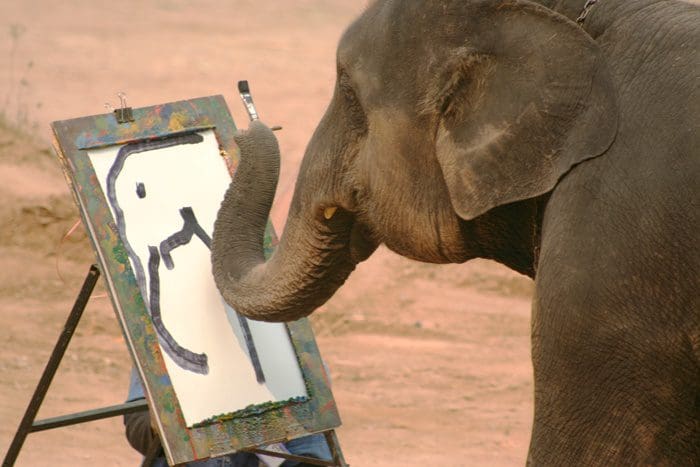
Have Trunk, Can Paint: Pachyderms Redefine What Makes an Artist

Article Summary
Elephants are known for their massive size, intelligence, social nature, and their need for protection. What some may not know is they truly artistic. Give an elephant a paintbrush and a canvas and you’ll be amazed and inspired by their abilities to express themselves through art.
They learned to paint in sometimes less than a week and immediately their paintings were selling for hundreds of dollars. As they perfected their skills, their paintings fetched thousands of dollars. The highest priced work of art sold for $40,000 in 2004. Plai Chompon is methodical in his artwork. First, he paints horizontal lines, then dots, and then adds curling lines before he considers his masterpiece complete. Jo optimizes the left side of the canvas, while Moshi often expands his painting to those around him. What do these artists all have in common? They are all elephants. Plai Chompon lives in Thailand and Jo and Moshi live at the Cleveland Zoo. Moshi likes to paint on canvas and on zookeepers.
What started as a way to enrich the lives of captive elephants and maybe earn some money for their care has turned into much more. It takes only a few days to a few weeks at the most to teach an elephant to pick up a paintbrush with paint on it and put it to paper. However, this elephant enrichment has taught humans much more about elephants than it has taught the elephants. As their keepers, researchers, and elephant enthusiasts have now learned from the work, elephants are true artists.
The elephants taught to paint start out by making random brush strokes, but progress to refine their talent. They will choose their own colors and make careful selections about what colors to use together in one painting. They learn to hold the brush delicately against the canvas and can paint both abstract designs and distinctive patterns. Some have received more advance artistic training and learned to paint images of flowers, trees, and other objects that rival the abilities of many human artists. The top elephant talents may be Paya and Hong. Both are residents of Thailand conservation centers. Paya, who enjoys dancing and movement while painting, focuses his talents on painting elephant heads and faces. Hong often paints line drawings of elephants caring colorful flowers in their trunks.
As it is with humans, not all elephants take to painting. Whether or not an elephant has an artistic interest is usually seen in the first few painting sessions. Many become bored with painting sessions and throw their paintbrushes, knock over the canvas, and generally find something more interesting to do with the painting supplies. But some elephants clearly enjoy putting paint to paper and their art tends to reflect their personalities.
Elephant art gives us a glimpse into the wild nature of elephants. The Calgary Zoo reports that even elephants living in the wild have been seen drawing in sand with sticks and rocks. It also shows us the complexity of elephants. They start out painting like any human child that experiments by slapping any paint onto a piece of paper. However, over time, as their talents become more refined and sophisticated, you can see the objects they are painting and gain insight into how they view the world, which is the goal of any artist, human or otherwise. As an artist in any format, theres a lot to learn from and admire about 10,000 pound creatures that create works of art with a trunk and a paintbrush.
References
The Asian Elephant Art & Conservation Project
elephantart.com/catalog/index.php
Cleveland Metroparks Zoo: Creative Elephants for Conservation
clemetzoo.com/whats_new/elephant_paint.asp
Calgary Zoo: Elephant Art
calgaryzoo.org/index.php?option=com_content&task=view&id=93&Itemid=248
Digital Journal: Elephant Art: Beauty to Behold
digitaljournal.com/article/264987